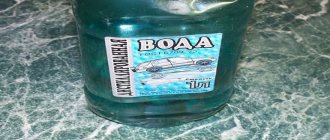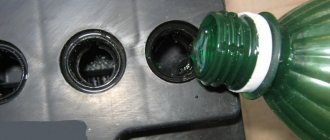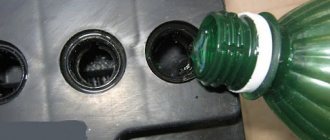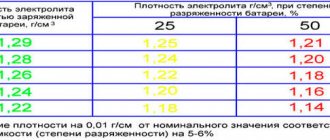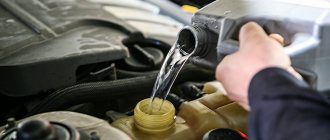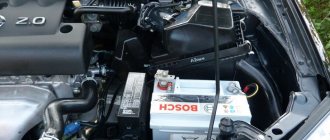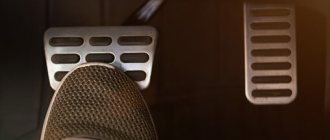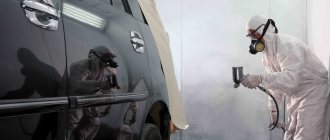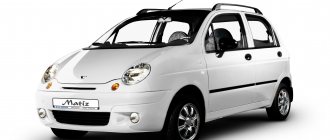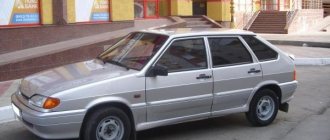If you do not monitor the electrolyte level, premature destruction of the battery plates begins. At the same time, you cannot overfill the water either - then the battery capacity drops, and in winter there is a risk of the electrolyte freezing.
You need to add distilled water to a level of 1.5-2 centimeters above the edge of the plates or 0.5 cm above the special indicator (“reeds”). The goal is to achieve a battery electrolyte density of 1.27 g/cm³ .
Do you know the correct level of electrolyte in the battery, how to determine it, how to maintain it at the required level, what to add and how to do it? No - then read the article.
Checking the electrolyte level
The presence of electrolyte is checked exclusively in serviced batteries. They are most often equipped with a transparent body, so inspection is carried out visually. For this purpose, special marks are made on the surface corresponding to a certain volume of liquid. Serviceable batteries with an opaque casing are also available. To determine to what level to add water to the battery in this case, the vehicle owner will need a special transparent tube with a diameter of 0.5 cm.
Read also: Instagram without registration
Fluid level check sequence:
- The battery cover is unscrewed;
- the transparent tube is lowered into the liquid, and it should rest against the bottom of the jar;
- its outer hole is clamped tightly with a finger;
- it is then removed from the battery to determine the electrolyte level.
Such a tube has minimum and maximum divisions. Accordingly, if the accumulated liquid is within these limits, the volume of electrolyte is normal. If the fluid is below the minimum, you need to add DV.
When is battery refilling required?
Most experts believe that car batteries do not require maintenance. Accordingly, adding water to it is irrelevant, but provided that the battery is used under normal conditions. It is imperative to check the fluid level for motorists who travel long distances in their own cars. In this case, the probability of converting the liquid into a vapor state is greatest. And also the active process of water evaporation is carried out in the event of failure of the relay regulator.
Main indicators of failure of the relay regulator:
- during the operation of the vehicle, the battery becomes very hot;
- drops of electrolyte are observed on the battery body;
- Strong steam comes out of the filler necks.
It is necessary to take into account the design of the battery. In serviced models, much greater evaporation of H2O occurs. Therefore, it is for them that it is worth knowing how much water to add to the battery. In maintenance-free models, evaporation of liquid into the environment is prevented by a sealed cast housing. Such batteries do not require additional maintenance.
How to add distilled water to a battery
If the density is higher than normal, this indicates evaporation of the liquid that needs to be added. How much water should I add to the battery? The level of the solution in the battery must be maintained 1-1.5 cm above the level of the plates. You cannot add distilled water more than the permitted amount. After refueling, be sure to re-check the density of the liquid by first charging the battery.
At the very beginning of the article, we already noted that a low level of electrolyte in battery banks can lead to destruction of the lead plates, so the electrodes cannot be dry, they are completely filled with solution. But the water level must be certain, 10-25 mm above the upper edge of the plates (depending on the battery model and the manufacturer’s recommendations), any deviations from the norm in any direction lead to undesirable, and sometimes even disastrous consequences:
- if there is not enough electrolyte in the battery, the battery quickly runs out, often fails completely, and the battery may even explode under load;
- if the level is too high, the required density is not achieved (the standard is 1.27 g/cm³), liquid begins to come out of the cans, and oxides appear on the body and terminals.
But overfilling of water is not as bad as underfilling, although it also does not bode well; for example, at low temperatures there may not be enough density to start the engine with the starter.
How to add water:
- on a maintenance-free or low-maintenance battery, use a slotted screwdriver or other flat object (for example, a coin) to remove the top caps from all cans;
- take a special measuring tool or a transparent tube (make a 10 mm mark on it), lower the measuring device into the jar until it comes into contact with the plates;
- holding the upper tip of the tube with your finger, remove it and look at the level;
Consequences of non-compliance with proportions
If the proportions are not met, the battery will not be able to accumulate the required amount of electric current.
If the battery is operated with a low level of distilled water for a long time, the chemical power source may fail due to excessive oxidation of the internal plates of the battery.
This process is observed if the lead gratings, which interact with air, are completely exposed. In turn, the resulting dielectric film prevents the normal passage of current.
Consequences of overflow
When overfilled, the battery's ability to store electricity is sharply reduced.
A higher level may cause other undesirable consequences during battery operation.
If the cans are filled to capacity, then when the battery is used in a car, the contents will splash while the car is driving on a bumpy road. Constant contact of the body metal with water and electrolyte will lead to the appearance of rust and through corrosion.
Also for this reason, the battery terminals may oxidize. The presence of a dielectric layer on wires and contacts can cause serious deviations in the operation of the vehicle's electrical system.
This phenomenon is the active movement of gas bubbles inside the electrolyte. Splashing acid can also lead to damage to various metal objects, as well as cause the growth of bacteria and fungi due to the presence of high humidity in the room.
Harm of underfilling
An insufficient amount of distillate in battery banks can lead to complete failure of the electricity source. Inexperienced car enthusiasts very often neglect regular battery inspections with mandatory checking of the cans.
For this reason, especially in the summer, the car simply may not start. If the machine is operated in a cool climate, the distillate level may decrease very slowly.
A gradual
decrease in the amount of mixture in the jars causes an acceleration of the sulfation process of the plates.
Oxidation of the lead grid is one of the main reasons for reducing battery life.
Insufficient distilled water will equally negatively affect the performance of a rechargeable source of electricity, regardless of whether the product is used on a machine or stationary.
When to add electrolyte and when to add water?
Since sulfuric acid is not consumed from the solution during standard battery operation, distilled water is used to replenish the level. The volume of liquid in the cans is brought to a normal level, which is marked with special marks on the plastic case. It is not recommended to pour in excess liquid, as there is a risk of the solution being released into the engine compartment of the car. Pure electrolyte is used when replacing working fluid in cans; the volume of solution required for refilling depends on the battery capacity.
Precautionary measures
Inside a maintenance-free battery, the gas may be under significant pressure. The composition of such a mixture can be highly flammable, so do not smoke while drilling the housing. Work must be carried out at a considerable distance from open fire, for example, a gas burner or fireplace.
In addition, to protect your eyes and skin from splashing acid, you will need to use the following personal protective equipment:
- Latex gloves.
- Glasses.
- Special clothes.
Closer to practice
If everything is clear with the definition of the problem, then the question arises: what is added to the battery - water or electrolyte? The result of measurements with a hydrometer will help with the answer: if the solution is too dense, then adding water will solve the problem. If the solution has too low a density, then you cannot do without an electrolyte.
Let's deal with water. Why is it so important to add distilled or, in extreme cases, melt water? The fact is that bottled water or tap water contains impurities that, when interacting with electricity, will at least produce sediment, and in worst cases will lead to complete deterioration of the battery. Therefore, the most purified water is necessary.
To add water, you will need an ordinary funnel, then charge the battery and re-check the density of the resulting mixture.
How do the properties of electrolyte change in a vehicle battery?
Many professionals consider the question of what to put in the battery to be absolutely incorrect, since the device is classified as a non-repairable element. However, a good battery is far from a cheap pleasure, so the desire of car owners to extend its service life is understandable. To ensure that refilling the battery does not lead to its complete failure, you first need to understand the processes that occur during the operation of the battery during its systematic charging and discharging.
Initially, from the factory, the battery contains an emulsion, which consists of thirty-five percent sulfuric acid, while the remaining sixty-five percent of the volume is distillate - purified water, without impurities. During operation, the device heats up, an electrolysis reaction occurs, and part of the water evaporates under the influence of high temperature and collects as condensate on the inner surface of the unit.
If the battery has a completely sealed design and there is no mechanical damage in the case, then when it cools, the steam turns into water and flows back down the walls of the device. If there is damage to the case as a result of operation of the device or due to poor manufacturing quality of the product, the water evaporates from the battery irretrievably.
In addition to the natural process of evaporation at operating temperatures, the so-called sulfation reaction occurs in the battery - the deposition of acid salts on the lead strips of the battery. As a result of this process, the electrolyte concentration decreases. Precedents when the density of the electrolyte drops are most often provoked by irregular functioning of the battery as a result of prolonged downtime of the car or incorrect operation of the battery - supplying too much current to the device or serious malfunctions in the vehicle electronics.
The role of electrolyte in a battery
The liquid electrolyte consists of sulfuric acid and pure distilled water. Pure sulfuric acid can melt lead, so it must be diluted to a ratio of about 1.27 g/cm³. Over time, it evaporates and the percentage of acid increases. The battery begins to fail, and if this situation is not corrected, the battery will become unusable.
You can determine how much water to add to the battery by checking the electrolyte level.
How to check the level at home:
- Unscrew the plugs
- Using a transparent plastic or glass tube, we collect the electrolyte covering the plates. (The body of a simple ballpoint pen is ideal)
- The liquid level should be approximately 1.5 - 2 cm.
- Depending on the battery manufacturer, different inspection marks are provided.
Important!
You only need to top up if the level has dropped in at least one of the cans.
Causes of low electrolyte levels:
- Evaporation of water
during overcharging and hot weather. It easily turns into steam, but acid does not. In this case, you need to add distilled purified water to bring the density to the desired parameter. - Crack in the body.
In this case, you will need to solder the case (if it is made of polypropylene) or dispose of the battery. After the seal is restored, you will need to add the prepared electrolyte. - Turning over.
At the ends of the body there are special drainage holes designed to allow vapors and hydrogen to escape during “boiling.” If the battery is inverted, some electrolyte will leak out. The level will have to be raised by adding electrolyte.
Charger
A constant current supply is provided, the strength of which is calculated depending on the battery capacity. It should have a value equal to 10% of the total battery capacity. That is, if the capacity is 75 Ah, then the current is 7.5 Amperes. The voltage is set to 14.4 Volts.
The procedure lasts quite a long time and takes about 10 hours. Due to the fact that there are no additional holes in the housing, there is a high probability of an explosion. After successful completion of the procedure, the voltage at the terminals should be 12.7 Volts.
Electrolyte to water ratio
To obtain 1 liter of electrolytic fluid with a density of 1.27-1.28, mix 0.772 liters of correction electrolyte and 0.295 liters of distilled water. During normal operation, only water evaporates, so you cannot add electrolyte instead of distillate. To avoid mistakes with the density, maintenance is carried out only after the battery is fully charged.
Overflow of water, at which the density drops to the level of 1.26, is considered uncritical. When this limit is lowered, it is already necessary to pump out part of the liquid, bring the density to the factory value, adding correction electrolyte.
Is it necessary at all or not?
Topping up the device is always necessary when the hydrometer detects an increase in the density of the composition. If this is not done, the battery will overheat greatly. All this will eventually lead to failure.
If you do not systematically add distillate to the battery when the acid saturation inside it increases, then the battery life will be reduced several times.
Attention! The purified aqueous composition must be added to the device to prevent exposure of the lead plates. If you don't do this, they will quickly collapse. The result will be the failure of the entire mechanism.
Do I need to service a maintenance-free car battery?
In frosty weather, the car may have difficulty starting. The motor does not have enough power from the battery to turn the shaft. The battery itself loses charge due to cold. This may occur due to a small amount of electrolyte in the battery banks. But there is no access to it, because today about 90% of all car batteries are maintenance-free batteries. We will analyze all the nuances of preventing such devices in our article.
Water inside the battery
How we figured out water AJ - 65%! But it is not simple (from the tap) , but distilled without any impurities (this is necessary for many reasons, if only because the resistance inside decreases, there is no sediment on the plates, etc.).
But its level is not constant. As is known from high temperatures in the engine compartment, from charging the generator (sometimes overcharging ), water can evaporate from the cans, and the electrolyte level drops.
Sulfuric acid does not evaporate, and therefore its concentration begins to increase; this is bad for the battery in several ways:
- High density negatively affects the plates, destroying them
- The level drops, which means the plates are exposed, thereby reducing the battery capacity and it is not able to start your car.
- At high acid concentrations, sulfation of the plates
To avoid this, you must replenish it - add water inside the battery to the required minimum.
How much distilled water should be added to the battery and how to do it correctly
If your battery is maintenance-free, you do not need to carry out any manipulations with liquids. A serviced lead-acid system will need to periodically add water. In order to determine how much liquid to add, you need to remove the top caps from the battery cans and check the density of the battery and the electrolyte level in each of the containers.
The amount of water that should be poured into the battery may vary, depending on its capacity and the operating conditions of the battery. It is worth thinking about how to add distilled water to the battery at any time, because the liquid level may become lower at the most inopportune moment. To do this, it doesn’t hurt to always have a suitable container for water in your car, for example, a liter bottle, and you can always add water. Do not allow the battery plates to become exposed - they will quickly crumble as a result of heating.
The algorithm for how to properly fill a battery with water at home is simple:
- Disconnect the battery from the vehicle's on-board network . Take it out of the car.
- Make sure that the surface on which it will be placed is level .
- Clean the battery from dust and dirt . You can do this with a soda solution.
- For maximum accuracy, use a disposable syringe . And for your own safety , wear technical gloves that you usually use for gardening or cleaning.
- Remove the battery caps to access the jars.
- Check the liquid level inside each can . Remember that normally the electrolyte should cover the battery plates by 1-1.5 cm.
- If the coating level of the plates is less, add 5 to 10 ml of distilled water to each battery compartment .
- If it turns out that the syringe has “overfilled”, simply suck out the excess liquid with a small rubber bulb to the desired level .
Below are some more tips regarding battery operation. This information will be useful if you do not know how to add water to the battery correctly:
- You cannot add fluid to the battery if you have just turned off the internal combustion engine . Let the battery “stand” for 7-8 hours (preferably at home). Only then open the battery.
- Also, after the battery is filled with distilled water, you cannot immediately start the engine .
- The waiting time after filling is until the next morning . Otherwise, the battery may immediately boil and the plates may crumble.
- Remember that the “country” version of the room used for filling the battery can only be used in the warm season . If the room is not heated, you should not perform such actions with the battery.
- It is important to know that using distilled water will not return the battery to its previous capacity , but will improve its performance for a certain period.
- Before starting the engine, always check the electrolyte level in the battery , keeping in mind the quantitative indicators.
What to do if you overfill it?
When adding distillate to jars, it is possible to accidentally exceed the maximum level.
Considering the possible negative consequences, overflow must be eliminated.
This operation is performed very simply:
- Using a rubber bulb or hydrometer, remove excess (it is recommended to lower the level below normal).
- Add a small amount of distillate (to the optimum level).
When adjusting the electrolyte level in jars by adding distilled water, it is recommended to monitor the density with a hydrometer.
Attention
! It is strictly forbidden to reduce the level of distilled water in the battery by tipping the product on its side. As a result of such actions, a short circuit may occur in the lead plates.
How to charge after topping up
Such batteries are not at all capricious, but still require some maintenance. The most common cases of battery malfunction: discharge and decrease in electrolyte levels. To solve problems, add water and charge.
Even if the part does not require deep, long-term charging, it is necessary to do so. During the process, the terminals can be cleaned of oxidation to ensure a strong connection. It is important to dry all surfaces of the case after filling the battery with water.
Attention! After topping up, the battery is charged after 3 or 4 hours.
3 charging methods worth using:
- Using direct current. Complex, but often used method. It is 100% infected, but it will take about 10 hours.
- Using constant voltage. There is less effect, but the method is simpler; it charges only 80% in a whole day.
- Combined. It is carried out using “smart” expensive equipment without much effort on the part of the device owner. Due to it, the charge level is checked automatically and the necessary voltage is supplied to replenish it. Boil-off and excessive current supply are completely eliminated. Such a charge will take approximately 12 hours, everything will depend on the degree of charge loss.
The most successful method is DC charging. Although the process requires constant monitoring, it gives good results.
Note! If you add water but do not charge the part, the engine will operate at an elevated temperature, which means the liquid will boil away faster. Consequently, the discharge will occur faster.
Battery distillate is a very important component, so it makes a difference what kind of water you fill. It is necessary to create the optimal concentration of electrolyte solutions, replenish the correct ratio and prevent overheating in the device. The main condition remains the use of a high-quality mixture that meets all norms and standards. The pouring process should not be performed frequently. In winter, you should not add water at all, since the electrolyte mass will be diluted, which means it may freeze.
Modern active vehicle safety systems
Active vehicle safety systems are aimed at preventing emergency situations and preventing accidents. The vehicle's electronic control unit is responsible for monitoring active safety systems in real time.
1.Anti-lock braking system or ABS
The car's wheels may become blocked during sudden braking and high speed driving. Controllability tends to zero and the likelihood of an accident increases sharply.
The anti-lock braking system forcibly unlocks the wheels and returns control of the car. A characteristic sign of ABS operation is the beating of the brake pedal. To increase the effectiveness of the anti-lock braking system when braking, depress the brake pedal as hard as possible.
The system avoids slipping and makes it easier to climb uphill on slippery road surfaces.
The system is aimed at ensuring vehicle stability when driving on the road. Efficient and reliable in operation.
4.Brake force distribution system or EBD
Allows you to prevent the car from skidding when braking due to the uniform distribution of braking force between the front and rear wheels.
5.Differential lock
The differential transmits torque from the gearbox to the drive wheels. The lock allows for uniform transmission of force, even if one of the drive wheels has insufficient traction with the road surface.
6.Assistance system for ascent and descent
Ensures that optimal speed is maintained when descending or ascending a mountain. If necessary, brakes one or more wheels.
7.Parking sensors
A system that simplifies parking a car and reduces the risk of collision with other vehicles when maneuvering in a parking lot. A special electronic display indicates the distance to the obstacle.
8.Preventive emergency braking system
Capable of operating at speeds over 30 km/h. The electronic system automatically monitors the distance between cars. If the vehicle ahead comes to a sudden stop and there is no reaction from the driver, the system automatically slows down the car.
Modern car manufacturers pay a lot of attention to active and passive safety systems. They are constantly working on their improvement and reliability.
Obtaining distillate at home
There are motorists who do not go to the store for DV. They produce it themselves at home. This is mainly the older generation, who lived through times of shortage, and people living in settlements remote from the city, where many products simply do not arrive.
If you want to prepare DV yourself, you should understand that it will not be of high quality, since for this you need to have special expensive equipment - a distiller. But as an alternative, a regular moonshine still without a coil is suitable. The productivity of the DV when using this option will be approximately 1 glass in 3-4 hours.
The formula of distilled water is H2O. A high-quality liquid should not contain foreign impurities. It is impossible to achieve such a result under domestic conditions; a small content of metal salts will still remain.
Recommendations:
- If you urgently need to add water to the battery, you can take it from the tap into a plastic bottle and put it in the freezer for 2-3 hours. You should only use ice that has been melted beforehand. Unfrozen water is drained into the sink. The DV obtained in this way will cause minimal damage to the battery.
- Another way is to collect rainwater in a plastic container, carefully filter it, and then use it for its intended purpose.
Important! The collected water for the battery should not come into contact with iron objects. For example, water running off the metal roof of a house is not suitable for this purpose.
Owners of serviced car batteries need to regularly monitor the level of electrolyte in them and, if necessary, add pure H2O, free of minerals and organic additives. This water is called distilled and is an important component of the battery fluid. Its task is to maintain the chemical composition of the electrolyte at an optimal level, thereby guaranteeing high-quality battery operation.
Before you find out how to properly pour purified liquid into the battery, it is important to remember that it is prohibited to use tap or boiled water for this purpose. They contain a lot of foreign impurities (iron, calcium, magnesium, chlorine), which are deposited on the metal plates of the battery during charging. This “scale” leads to a decrease in battery capacity and destruction of its plates. This changes the density of the electrolyte in the battery.
A guide to restoring equipment using distillate
Over time, the amount of lead sulfate deposited on the plates becomes so large that the battery completely loses its original properties.
The only way to revive it from this state is to carry out desulfation, that is, to remove these salts.
There are several ways:
- Mechanical.
- Chemical.
- Electrochemical.
The first option involves disassembling the case, removing the plates, and then mechanically manually cleaning them from salts.
The second uses a lead sulfate corrosive agent. However, the effectiveness of both methods is quite questionable, since as a result the battery may become unusable.
The third method is the most optimal. It uses a special charger with a desulfation function.
Its application is quite simple:
- Connect the battery filled with distilled water to the charger.
- Plug in and monitor the display indicators.
If such a device is not available, you can use a standard charger according to the following instructions:
Bring the battery level to the mark with distilled water.- Connect to the charger and set the current to 14 V and 1 A.
- Leave to work for 8-10 hours.
- Disable for 24 hours.
- Next, connect the charger to 14 volts and 2 amperes.
- Leave it to charge for 8 hours.
As a result, the battery voltage should increase to 12 V, and the electrolyte density to 1.12. Then, a day later, a low-beam light bulb is connected to the battery. It should work until it discharges to 9 volts with the same density.
After this, all previous steps are repeated. In this case, the density indicator should increase to 1.16. The procedure should be repeated sequentially until its value increases to 1.28.
Features of servicing Mutlu, Bear, Beast 60 Ah and Varta devices
For ease of maintenance, Mutlu brand batteries are equipped with a charging and charging indicator.
The characteristic state of the device corresponds to its color:
If the color is yellow or white, refilling with distillate is required. It is entirely carried out according to the mechanism discussed above.
battery with a capacity of 60 Ah also has a charging indicator and electrolyte level with the following characteristics:
- Green – charged.
- White – low density, requires charging.
- Red – electrolyte refilling is required.
When the indicator color is red, it is necessary to top up the battery with distilled water according to the scheme discussed above.
Bear and Warta batteries are filled as standard. In addition, the manufacturer Varta has released a special refilling container that can be inserted into six cans at once.
Volume
How much distilled water should I add to the battery? What level is acceptable? It is necessary to top up until the plates disappear and are no longer visible. Translating the values into numbers, the amount of water depends on the total capacity of the battery, so you need to focus on hiding the plates with electrolyte by 1.5-2 cm. It is at this level that the required electrolyte density of 1.27 g/cm3 is achieved.
Important: if, when adding water, the level is exceeded, the density will decrease, and there will be a possibility of the battery “freezing” in winter. When the level is exceeded, you can pump out the water using the syringe that was used to add it.
As a result, we can say that adding water to serviced batteries is an immediate necessity. The situation with maintenance-free batteries is different - it depends only on the wishes of the car owner. But in any case, you must remember that adding water is a temporary measure! After some time, it will still become unusable, and you will have to buy a new one.
How much liquid should I add?
The amount of water added to the battery depends on how low the level is inside the cans .
Sometimes, it is enough to pour in 50 ml to restore the battery's functionality.
If distilled water has not been added for a year or more, the contents may almost completely evaporate .
Each jar of a new battery contains an average of about 700 ml of distillate. When water evaporates, the volume may decrease slightly (with regular maintenance), so if the decrease in level did not occur as a result of the battery tipping over, then to restore the battery’s functionality it will be enough to purchase a liter container of distilled water.
